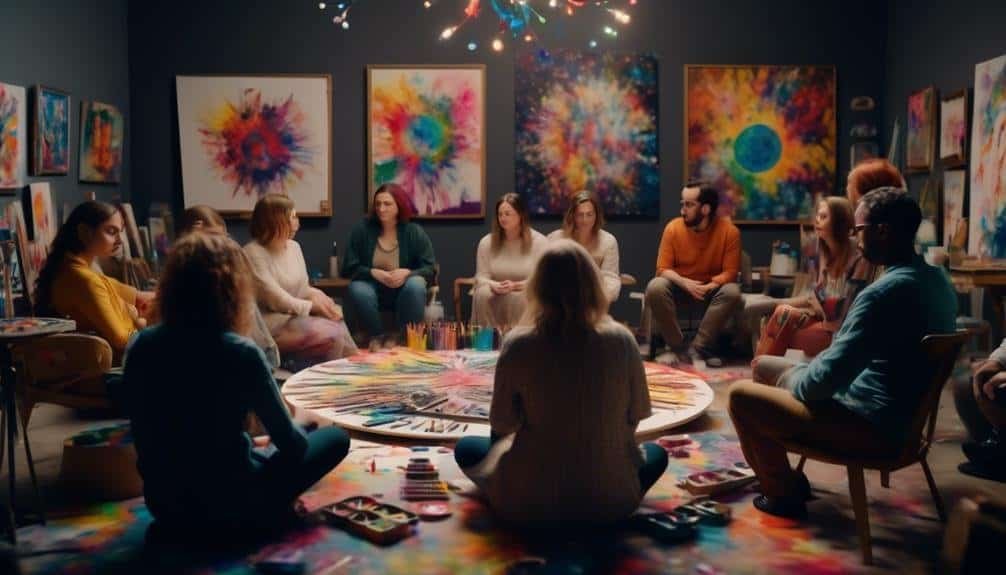Art Therapy for Neurodiverse Individuals
Art therapy has emerged as a valuable tool for supporting individuals with neurodiverse conditions, offering a wide range of benefits that cater to their unique needs.
By providing a non-verbal means of communication and self-expression, art therapy allows individuals to explore their inner thoughts and emotions in a safe and supportive environment.
Through the use of various artistic modalities, individuals can tap into their sensory experiences, cultivate self-awareness, and develop strategies for emotional regulation.
Furthermore, art therapy fosters social connections and promotes overall well-being.
As we delve further into this topic, we will explore the specific ways in which art therapy can be tailored to meet the diverse needs of neurodiverse individuals, offering a holistic approach to their development and growth.
Key Takeaways
- Art therapy provides a safe and supportive space for neurodiverse individuals to express themselves and develop essential skills.
- It allows for a deeper understanding of emotions and provides sensory stimulation and relaxation, reducing anxiety and stress.
- Art therapy is a unique avenue for self-expression and emotional regulation, enhancing coping strategies and improving self-esteem.
- Sensory-friendly approaches and supportive environments are crucial in art therapy, including the use of sensory-friendly materials and creating individualized sensory experiences.
Understanding Neurodiversity
Neurodiversity encompasses a spectrum of neurological differences that contribute to unique ways of thinking, learning, and experiencing the world. It is crucial to raise neurodiversity awareness and promote inclusive practices within educational, professional, and therapeutic settings. Understanding individual needs is at the core of embracing neurodiversity. Tailored interventions, such as art therapy, can provide a safe and supportive space for neurodiverse individuals to express themselves and develop essential skills.
Benefits of Art Therapy
Art therapy offers a safe and supportive environment for individuals to express their emotions through various artistic mediums, allowing for a deeper understanding of their inner world.
Additionally, the sensory stimulation and relaxation experienced during art-making can provide a calming effect, reducing anxiety and stress.
These benefits can be particularly impactful for neurodiverse individuals, offering them a unique avenue for self-expression and emotional regulation.
Emotional Expression Through Art
Encouraging emotional expression through art can be a powerful tool for promoting self-discovery, healing, and personal growth in neurodiverse individuals. Through creative expression, individuals can experience emotional healing and gain insight into their inner world.
Here are five compelling ways art therapy facilitates emotional expression:
- Providing a safe space for exploring and processing complex emotions
- Allowing for non-verbal communication and expression of feelings
- Fostering a sense of empowerment and control over one's emotions
- Encouraging mindfulness and self-awareness through the artistic process
- Helping individuals externalize and transform their emotions through the creation of art
Sensory Stimulation and Relaxation
Exploring the sensory stimulation and relaxation benefits of art therapy further illuminates the transformative potential of creative expression for neurodiverse individuals. Art therapy offers a range of relaxation techniques and sensory engagement activities that can have a profound impact on individuals with neurodiverse conditions. Through the use of various art materials and techniques, individuals can engage their senses in a calming and therapeutic manner, promoting relaxation and stress reduction. This sensory stimulation can help individuals regulate their emotions and find a sense of calm and comfort. The table below outlines some common relaxation techniques and sensory engagement activities used in art therapy for neurodiverse individuals.
| Relaxation Techniques | Sensory Engagement | Benefits |
|---|---|---|
| Deep breathing exercises | Texture exploration | Calming the nervous system |
| Guided imagery | Aromatherapy | Reducing anxiety and stress levels |
| Progressive muscle relaxation | Visual stimulation | Improving focus and concentration |
Expressive Art Modalities
Using a wide range of creative methods and techniques, expressive art modalities offer neurodiverse individuals a powerful means of self-expression and emotional exploration.
- Art therapy techniques provide a safe space for emotional expression through art, allowing individuals to convey feelings that may be challenging to articulate verbally.
- Sensory friendly approaches cater to individualized sensory experiences, promoting overall well-being and embracing individual creativity.
- Cultivating self-awareness through expressive arts techniques enables individuals to explore and understand their emotions and experiences more deeply.
- Building social connections through collaborative art projects fosters a sense of community and belonging, enhancing social skills and interpersonal relationships.
- Mindfulness and grounding incorporated in sensory based interventions help in managing emotional regulation, offering a sense of calm and stability in understanding neurodiversity.
Expressive art modalities create supportive sensory environments using sensory-friendly art materials, offering a range of benefits such as sensory stimulation and relaxation. Through these modalities, individuals can experience the transformative power of art therapy, promoting self-expression and emotional well-being.
Sensory-Friendly Approaches
When working with neurodiverse individuals in art therapy, it is crucial to consider sensory-friendly approaches that cater to their unique sensory needs.
Utilizing sensory-friendly art materials, creating individualized sensory experiences, and establishing supportive sensory environments can significantly enhance the therapeutic process for neurodiverse individuals.
Sensory-Friendly Art Materials
Sensory-friendly art materials are essential for creating a supportive and inclusive environment for neurodiverse individuals engaging in art therapy. When considering sensory-friendly approaches, it's crucial to provide adaptive art tools and activities that cater to the specific sensory needs of each individual.
Here are five essential sensory-friendly art materials to consider:
- Noise-canceling headphones to minimize auditory distractions
- Weighted or textured brushes for tactile stimulation
- Non-toxic, low-odor paints and markers to accommodate sensory sensitivities
- Adjustable easels and workstations to accommodate different physical needs
- Visual schedule and clear instructions to provide predictability and structure
Individualized Sensory Experiences
Ensuring a personalized approach that caters to the unique sensory needs of each individual is paramount when creating a nurturing environment for neurodiverse individuals engaging in art therapy. Personalized therapy involves tailoring sensory experiences to suit the specific preferences and sensitivities of the individual. Sensory exploration allows for the use of various materials, textures, and stimuli to engage the senses and promote self-expression. The following table outlines examples of individualized sensory experiences that can be incorporated into art therapy sessions:
| Sensory Experience | Description | Example |
|---|---|---|
| Visual | Incorporating specific color palettes | Using calming pastel colors |
| Tactile | Providing a variety of tactile materials | Working with soft fabrics |
| Auditory | Using music or soundscapes | Playing nature sounds during sessions |
Supportive Sensory Environments
Creating supportive sensory environments in art therapy involves tailoring the space and experiences to accommodate the unique sensory needs and preferences of neurodiverse individuals, fostering a conducive atmosphere for self-expression and emotional exploration.
- Sensory integration: Implementing activities that promote sensory integration, such as tactile art materials and soothing music.
- Calming techniques: Incorporating calming techniques like deep pressure activities and sensory-friendly lighting to create a tranquil setting.
- Sensory processing: Understanding and addressing sensory processing challenges through individualized strategies and tools.
- Environmental adaptations: Making environmental adaptations such as reducing clutter, providing noise-canceling headphones, and offering sensory-friendly seating options.
- Personalized sensory experiences: Tailoring art therapy sessions to each individual's sensory profile to ensure a comfortable and inclusive environment for creative expression.
Cultivating Self-Awareness
Understanding one's own emotions, thoughts, and behaviors is a fundamental aspect of personal growth and well-being, particularly for neurodiverse individuals engaging in art therapy. Cultivating self-awareness through art therapy involves encouraging self-reflection and exploration of one's inner world. For neurodiverse individuals, this process can be especially empowering as it allows them to gain insight into their unique perspectives and experiences.
Art therapy provides a safe and nonverbal means for individuals to express and explore their emotions, facilitating a deeper understanding of themselves. Through creative expression, individuals can gain a better understanding of their thought patterns, emotional triggers, and behavioral tendencies. This self-awareness can then be harnessed to navigate social interactions, manage sensory experiences, and develop coping strategies tailored to their specific needs.
Moreover, as individuals engage in the artistic process, they may uncover hidden strengths and talents, fostering a sense of personal growth and self-empowerment. Art therapy offers a supportive environment where individuals can embrace their neurodiversity and celebrate their individuality, ultimately promoting a positive sense of self and well-being.
Embracing Individual Creativity
Encouraging the exploration of diverse artistic expressions can be a transformative aspect of art therapy for neurodiverse individuals. Embracing individual creativity within art therapy sessions allows for a rich and rewarding experience.
Here are five key elements to consider when embracing individual creativity:
- Freedom of Expression: Providing a safe space where individuals feel free to express themselves without judgment.
- Exploration of Unique Perspectives: Encouraging individuals to explore and share their unique viewpoints through their art.
- Tailored Approaches: Recognizing and respecting that each individual may require different approaches to creative expression.
- Validation of Personal Narratives: Acknowledging and validating the personal narratives and experiences reflected in the artwork.
- Celebration of Divergent Thinking: Embracing and celebrating the diverse ways in which individuals approach creative tasks.
Managing Emotional Regulation
Art therapy offers valuable tools for managing emotional regulation in neurodiverse individuals, addressing the unique challenges they may face. Sensory-based interventions provide a means of self-soothing and navigating overwhelming feelings, while expressive arts techniques offer a nonverbal outlet for emotional expression.
Additionally, mindfulness and grounding practices can help cultivate a sense of calm and stability amidst fluctuating emotions.
Sensory-Based Interventions
Individuals with neurodiverse conditions often benefit from sensory-based interventions to help manage their emotional regulation. Sensory integration and creative expression play a crucial role in supporting neurodiverse individuals. Here are five key points to consider regarding sensory-based interventions:
- Sensory processing techniques can provide therapeutic benefits for individuals with neurodiverse conditions.
- Engaging in sensory-based activities can help regulate emotions and decrease anxiety.
- Sensory interventions offer a non-verbal way to communicate and process emotions.
- Creating a sensory-friendly environment can enhance emotional regulation and well-being.
- Incorporating sensory tools such as fidget toys, weighted blankets, or sensory bins can offer comfort and aid in emotional self-regulation.
Understanding and implementing sensory-based interventions can significantly contribute to the emotional well-being of neurodiverse individuals.
Expressive Arts Techniques
In facilitating emotional regulation for neurodiverse individuals, the incorporation of expressive arts techniques offers a valuable avenue for self-expression and introspection. Artistic expression through various mediums such as painting, drawing, and sculpting provides therapeutic benefits by allowing individuals to externalize their internal experiences. Creative exploration within the safety of the therapeutic relationship fosters personal growth and self-awareness, enabling individuals to navigate and understand their emotions. Through the process of creation, individuals can explore their inner world, gain insight into their thoughts and feelings, and develop coping strategies. This form of non-verbal communication can be especially beneficial for those who struggle with traditional talk therapy. The following table visually represents the emotional journey experienced by individuals engaging in expressive arts techniques.
| Emotional Journey | Visual Representation | Description |
|---|---|---|
| Self-Exploration | Image of a labyrinth | The journey of introspection and self-discovery |
| Release | Painting of a storm | Letting go of pent-up emotions and finding relief |
| Empowerment | Sculpture of a phoenix | Rising above challenges and embracing personal strength |
| Transformation | Collage of growth | Evolving and embracing positive change |
| Connection | Art piece of hands | Building connections and fostering a sense of belonging |
Mindfulness and Grounding
Engaging in mindfulness and grounding techniques fosters a deeper connection with one's inner experiences, complementing the expressive arts techniques used in emotional regulation for neurodiverse individuals. These practices emphasize the mind-body connection, promoting sensory awareness and self-compassion. Here are five key aspects to consider:
- Mindfulness practices cultivate present-moment awareness and non-judgmental acceptance.
- Grounding techniques help individuals stay connected to the present reality and manage overwhelming emotions.
- Developing sensory awareness enhances the understanding of one's emotional and physiological responses.
- Encouraging the exploration of different grounding strategies tailored to individual preferences and needs.
- Incorporating mindfulness into daily routines to support emotional regulation and reduce stress.
Art Therapy Techniques
Utilizing a variety of innovative and tailored art therapy techniques, practitioners can effectively support neurodiverse individuals in expressing their emotions, enhancing their communication skills, and fostering personal growth. Art therapy benefits neurodiverse individuals by providing a safe and nonverbal space for creative expression, allowing them to communicate and process their feelings in a unique and impactful way. Creative expression techniques such as painting, drawing, sculpting, and collage can be particularly beneficial for individuals with neurodiverse conditions, as they offer alternative forms of communication and self-expression. These techniques enable individuals to externalize their internal experiences, explore their identities, and develop a deeper understanding of themselves and their emotions.
| Art Therapy Techniques | Description |
|---|---|
| Painting | Utilizing colors and strokes to convey emotions and thoughts |
| Drawing | Expressing feelings and experiences through visual representation |
| Sculpting | Using tactile materials to explore and communicate inner sensations |
| Collage | Creating visual narratives to process and communicate personal stories |
Engaging in these techniques within a therapeutic context can empower neurodiverse individuals to develop coping strategies, improve self-esteem, and enhance their overall well-being. Art therapy techniques provide a valuable means for individuals to explore and express themselves, contributing to their personal growth and emotional resilience.
Building Social Connections
Supporting neurodiverse individuals in developing meaningful social connections is an essential aspect of their holistic well-being and personal growth. It's crucial to create an environment that fosters social engagement and understanding of neurodiversity. Here are five key strategies for building social connections:
- Creating Inclusive Spaces: Establishing inclusive environments where neurodiverse individuals feel accepted and valued is vital for community building.
- Developing Communication Skills: Providing opportunities for social skills development through structured activities and therapeutic interventions can enhance individuals' ability to engage in social interactions.
- Peer Support Programs: Implementing peer support programs can offer a sense of belonging and understanding, promoting positive social connections within the neurodiverse community.
- Embracing Differences: Encouraging acceptance and celebration of neurodiversity within social settings can empower individuals to embrace their unique qualities and foster genuine connections.
- Facilitating Social Activities: Organizing group activities that align with individuals' interests and strengths can create opportunities for meaningful social engagement and relationship building.
Promoting Overall Well-Being
To enhance the overall well-being of neurodiverse individuals, it is essential to cultivate a supportive and inclusive environment that addresses their unique needs and fosters a sense of belonging and empowerment.
Creative self-care plays a crucial role in promoting the well-being of neurodiverse individuals. Engaging in therapeutic art-making activities provides a non-verbal outlet for self-expression, allowing individuals to explore and communicate their emotions in a safe and supportive space. Through art therapy, individuals can develop coping strategies, improve self-esteem, and reduce stress and anxiety.
The process of creating art can be a calming and meditative experience, promoting mindfulness and self-awareness. Furthermore, the tangible outcomes of artistic expression can serve as a source of pride and accomplishment, contributing to a positive sense of self-worth.
Art therapy also provides a platform for individuals to connect with others who share similar experiences, fostering a sense of community and understanding.
Conclusion
In conclusion, art therapy offers numerous benefits for neurodiverse individuals. It provides a sensory-friendly and expressive outlet for self-expression and emotional regulation. By utilizing various art modalities, individuals can cultivate self-awareness, build social connections, and promote overall well-being.
The use of art therapy techniques can assist in managing emotional regulation and providing a visual representation of ideas. This ultimately enhances the quality of life for neurodiverse individuals.







